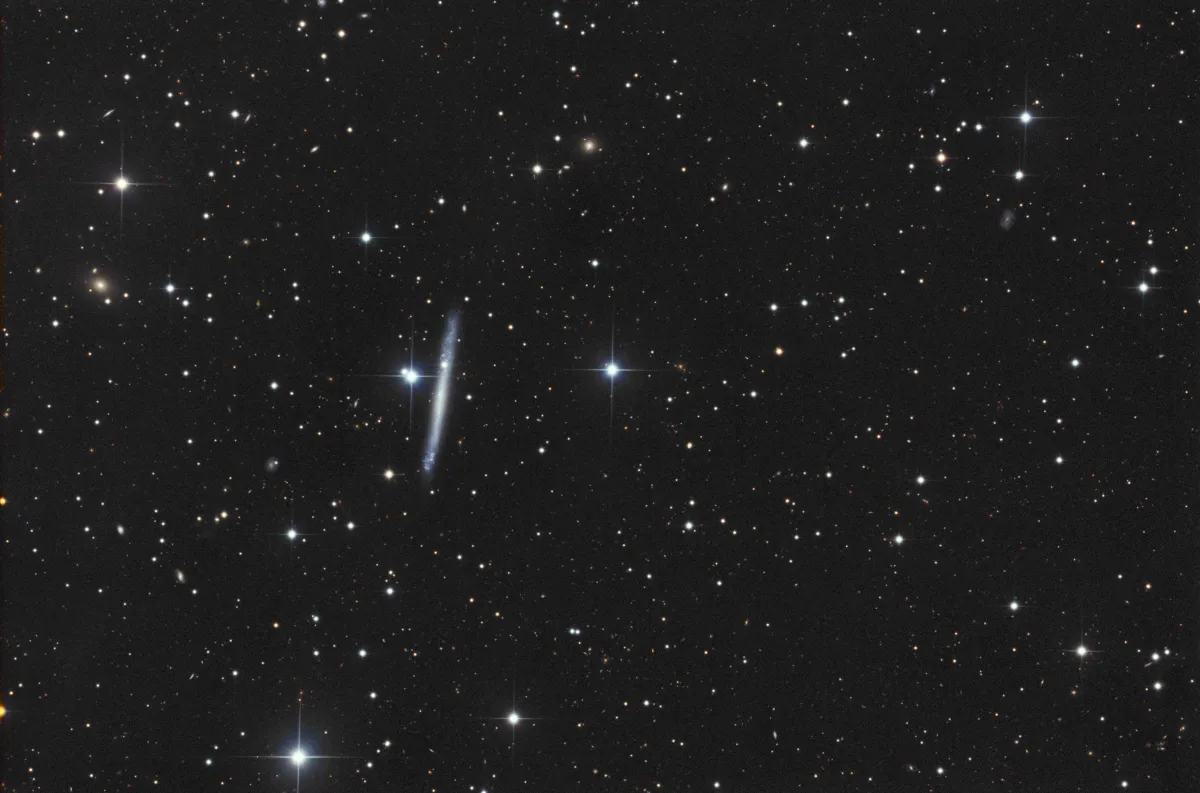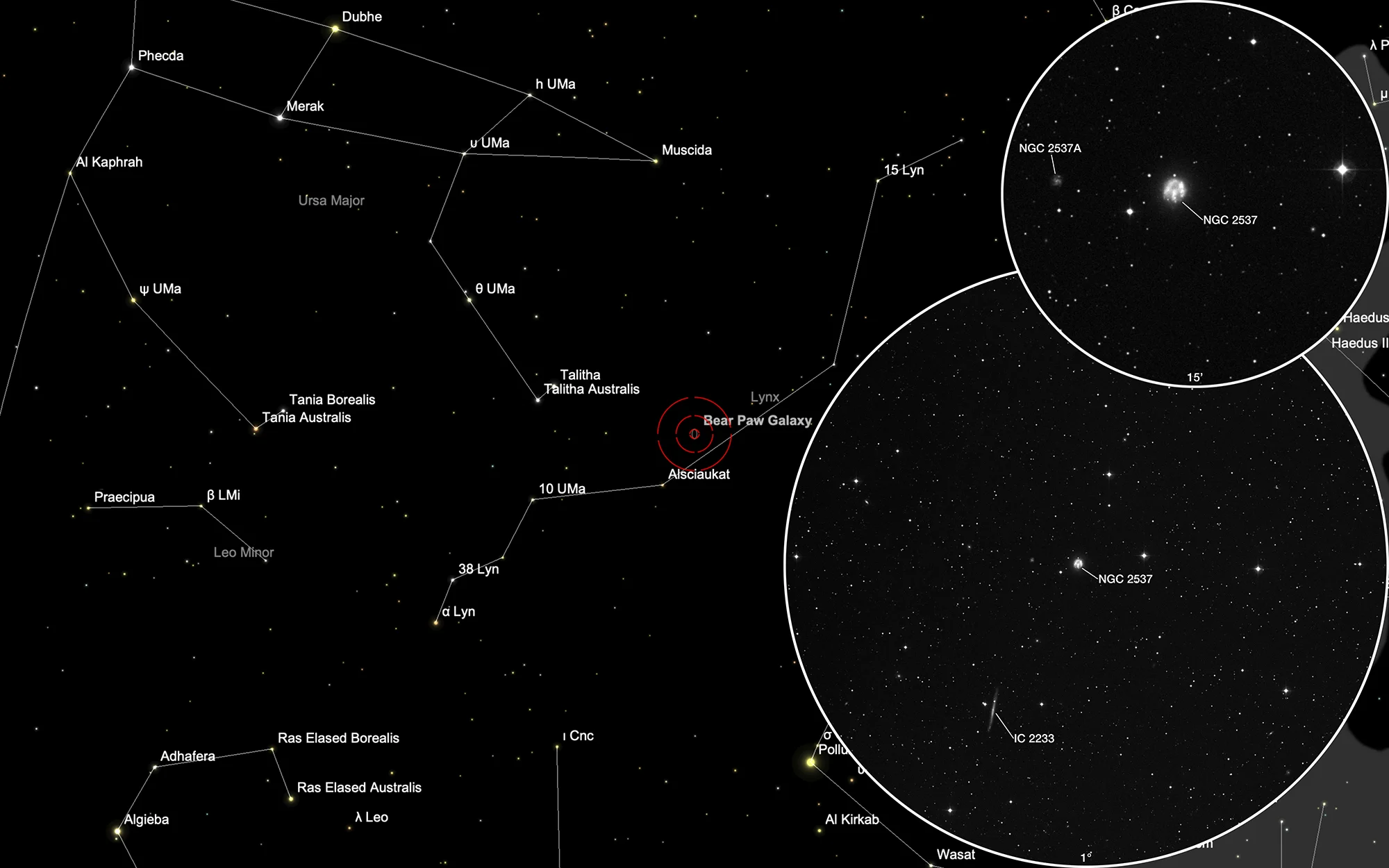Bear Paw Galaxy (NGC 2537, Arp 6) & IC 2233


History
While looking through his 18.7 inch reflecting telescope William Herschel found on 6 February 1788 an object that he described as follows: «Pretty bright, round, almost of an even light throughout, approaching to planetary, but ill defined and a little fainter on the edges 3/4 or 1' diameter.» He cataloged it as IV 55 (class IV: planetary nebulae: stars with burs, with milky chevelure, with short rays, remarkable shapes, etc.) [464]
In 1833 John Herschel listed this object as h 491 and described it as follows: «Pretty faint; round; 60"; very nearly uniformly bright, but hazy at edges. It is a resolved globular cluster. Being a remarkably fine night, I see the stars; they are 20 m; a star 9.10 mag is 40° south following at distance 2'.» [466] In his «General Catalogue» appeared in 1864 he listed the object a globular cluster with the designation GC 1629. [467] Dreyer took over this mis-classification in his «New General Catalogue» of 1888 where he listed the object as NGC 2537. [313]
In 1966 Halton Arp published his «Atlas of Peculiar Galaxies», where he ordered galaxies into groups based on purely morphological criteria. The galaxy NGC 2537 is listed as Arp 6 in the first group «spiral galaxies, low surface brightness» (group #1-6). [199]
The edge-on galaxy IC 2233 was discovered on 25 March 1894 by the British Astronomer Isaac Robers. He found it by photography, using the 20 inch reflector at his observatory «Starfield», Crowborough Hill, Sussex. [277]
Physical Properties
NGC 2537 is a compact blue dwarf galaxy with a redshift of z=0.001491. According to Simbad estimated distances range from 6.9 to 15 Mpc. The small spiral galaxy NGC 2537A (MCG+08-15-051) four arcminutes to the east shows a redshift of z=0.04001 and therefore is much further away and not associated with its optical neighbour. [145, 582]
IC 2233 is a superthin edge-on galaxy with low surface brightness and very low global star formation rate. It shows a redshift of z=0.001868. Simbad lists estimated distances ranging from 10.4 to 14.6 Mpc. Although the galaxy is at a projected distance of 16.7 arcminutes to NGC 2537 they seem not to be a bound pair and most likely lie at different distances. There is also no compelling evidence of a recent minor merger in either IC 2233 or NGC 2537, suggesting that both are examples of small disk galaxies evolving in relative isolation. [145, 582] IC 2233 is surrounded by a compact dark matter halo, which may be responsible for the superthin nature of the stellar disc. [583]
| Name | RA | Dec | Type | bMag | vMag | B-V | SB | Dim | PA | z | D(z) | MD | Dreyer Description | Identification, Remarks |
|---|---|---|---|---|---|---|---|---|---|---|---|---|---|---|
| NGC 2537 | 08 13 14.4 | +45 59 29 | Gx (SBm) | 12.3 | 11.7 | 0.6 | 12.6 | 1.7 × 1.5 | 162 | 0.001438 | 6.07 | 7.940 | globular, pB, pL, R, rrr, st 20 | WH IV 55; h 491; GC 1629; UGC 4274; MCG 8-15-50; MK 86; KUG 0809+461; CGCG 236-35; KARA 235; Arp 6; VV 138; Bear claw/paw galaxy |
| NGC 2537 A | 08 13 41.1 | +45 59 36 | Gx (SBc) | 16.0 | 15.4 | 0.6 | 14.2 | 0.6 × 0.6 | 0.039976 | 168.8 | globular, pB, pL, R, rrr, st 20 | WH IV 55; h 491; GC 1629; MCG 8-15-51 | ||
| IC 2233 | 08 13 59.0 | +45 44 23 | Gx (SBcd) | 13.1 | 12.6 | 0.5 | 13.3 | 4.6 × 0.5 | 172 | 0.001801 | 7.61 | 13.350 | pB, L, E np sf, IV. 55 np | UGC 4278; MCG 8-15-52; CGCG 236-36; FGC 730 |
Finder Chart
The galaxy NGC 2537 is located in constellation Lynx. The best time for observation is September to June, when it is high in the sky during night.
